MN601 Assignment 1: Analyzing Network Project Management Case Study
VerifiedAdded on 2023/06/08
|6
|1507
|95
Case Study
AI Summary
This assignment analyzes a network project management case study, focusing on leadership, execution, risk management, and ethical considerations. The case study examines the leadership styles of two project managers, Bob and Jim, and their approaches to project execution, particularly concerning the ethical implications of utilizing company resources. The analysis delves into the project's execution challenges, including poor planning and the impact of unforeseen risks like weather conditions. The assignment also assesses ethical dilemmas, such as Bob's decision to use carpenters for personal work, and explores alternative ethical actions. The report concludes with a discussion on the importance of project management fundamentals and ethical decision-making in achieving project goals. It also provides a detailed risk analysis and ethical assessment of the scenario.
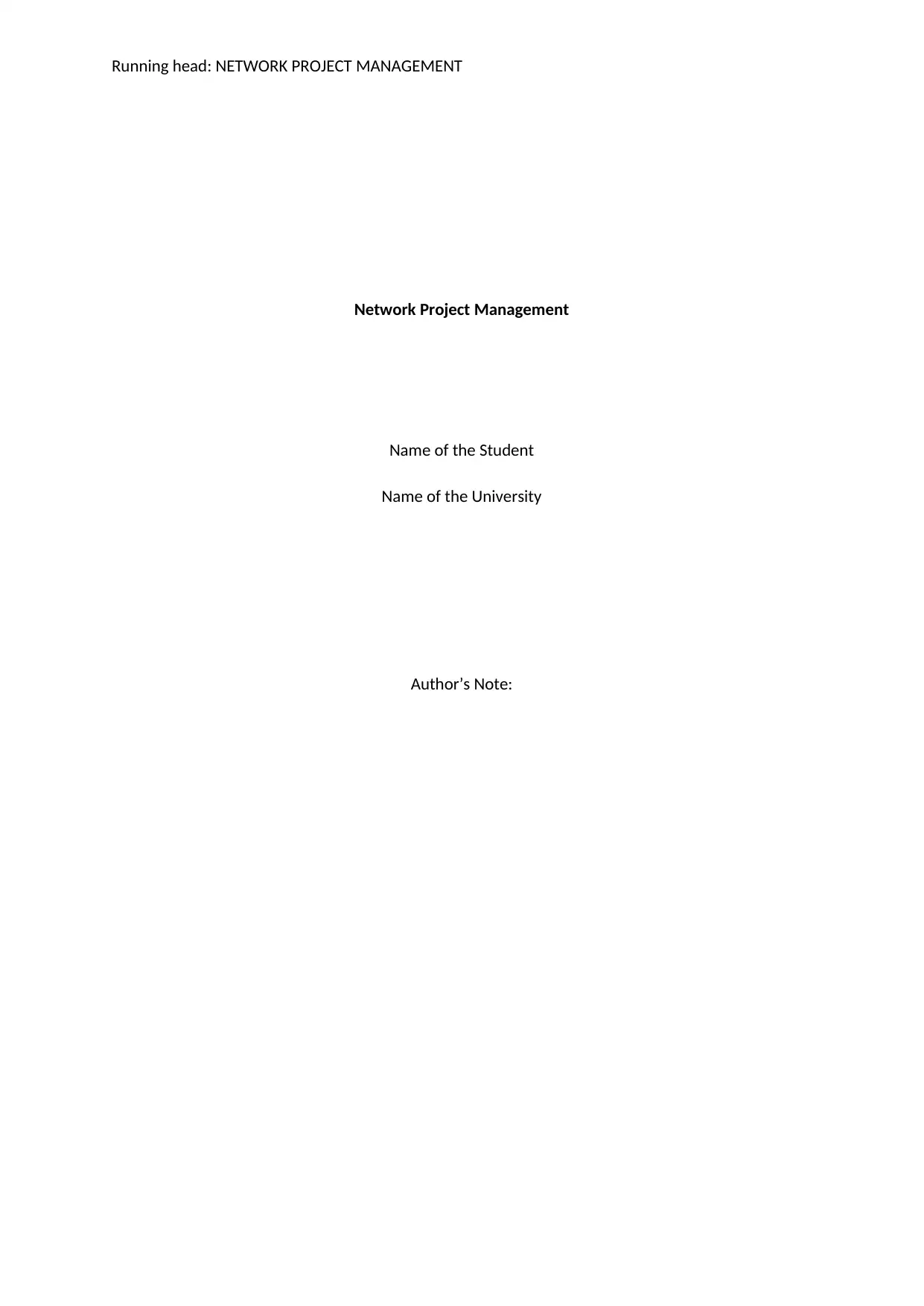
Running head: NETWORK PROJECT MANAGEMENT
Network Project Management
Name of the Student
Name of the University
Author’s Note:
Network Project Management
Name of the Student
Name of the University
Author’s Note:
Paraphrase This Document
Need a fresh take? Get an instant paraphrase of this document with our AI Paraphraser
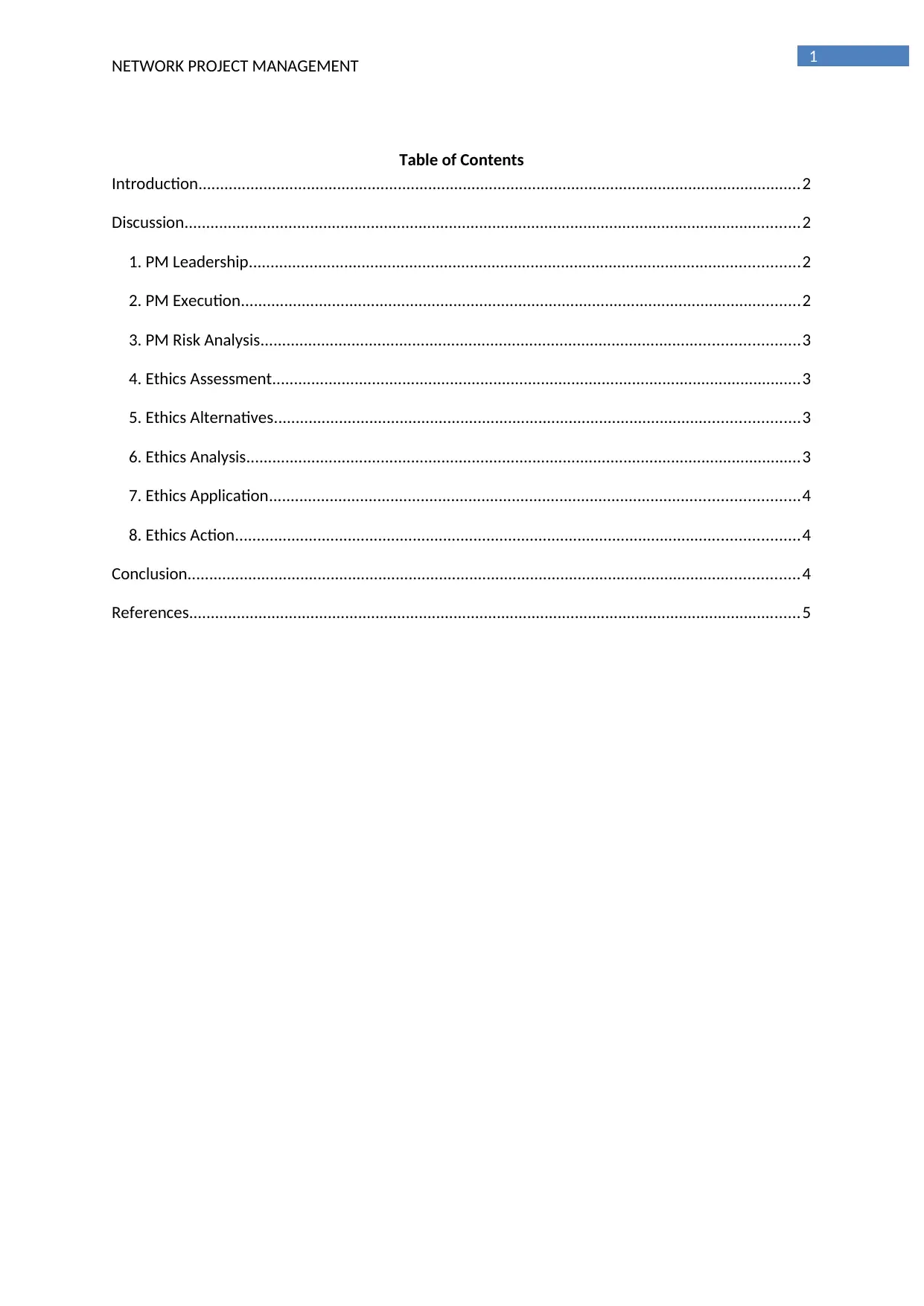
1
NETWORK PROJECT MANAGEMENT
Table of Contents
Introduction...........................................................................................................................................2
Discussion..............................................................................................................................................2
1. PM Leadership...............................................................................................................................2
2. PM Execution.................................................................................................................................2
3. PM Risk Analysis............................................................................................................................3
4. Ethics Assessment..........................................................................................................................3
5. Ethics Alternatives.........................................................................................................................3
6. Ethics Analysis................................................................................................................................3
7. Ethics Application..........................................................................................................................4
8. Ethics Action..................................................................................................................................4
Conclusion.............................................................................................................................................4
References.............................................................................................................................................5
NETWORK PROJECT MANAGEMENT
Table of Contents
Introduction...........................................................................................................................................2
Discussion..............................................................................................................................................2
1. PM Leadership...............................................................................................................................2
2. PM Execution.................................................................................................................................2
3. PM Risk Analysis............................................................................................................................3
4. Ethics Assessment..........................................................................................................................3
5. Ethics Alternatives.........................................................................................................................3
6. Ethics Analysis................................................................................................................................3
7. Ethics Application..........................................................................................................................4
8. Ethics Action..................................................................................................................................4
Conclusion.............................................................................................................................................4
References.............................................................................................................................................5
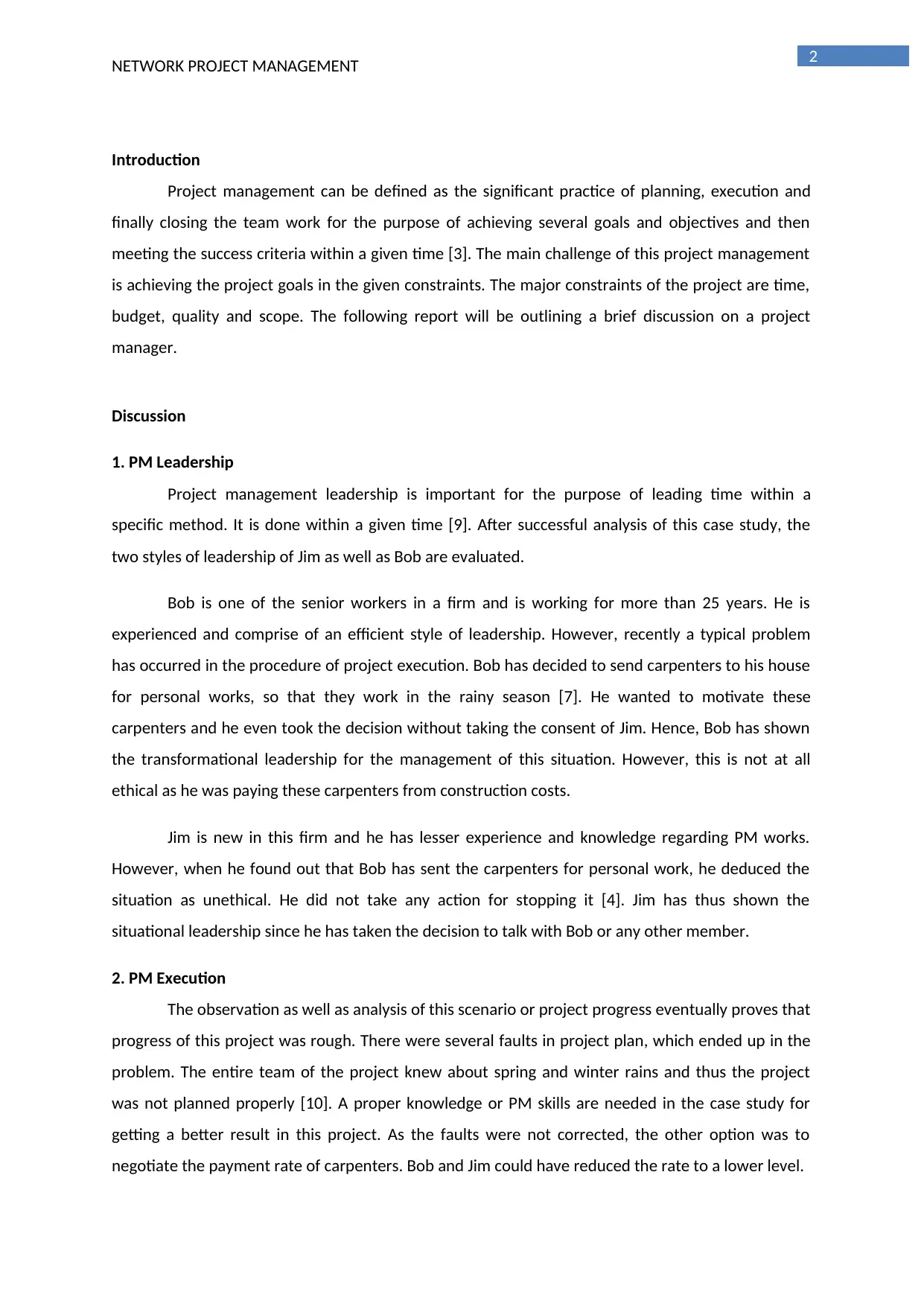
2
NETWORK PROJECT MANAGEMENT
Introduction
Project management can be defined as the significant practice of planning, execution and
finally closing the team work for the purpose of achieving several goals and objectives and then
meeting the success criteria within a given time [3]. The main challenge of this project management
is achieving the project goals in the given constraints. The major constraints of the project are time,
budget, quality and scope. The following report will be outlining a brief discussion on a project
manager.
Discussion
1. PM Leadership
Project management leadership is important for the purpose of leading time within a
specific method. It is done within a given time [9]. After successful analysis of this case study, the
two styles of leadership of Jim as well as Bob are evaluated.
Bob is one of the senior workers in a firm and is working for more than 25 years. He is
experienced and comprise of an efficient style of leadership. However, recently a typical problem
has occurred in the procedure of project execution. Bob has decided to send carpenters to his house
for personal works, so that they work in the rainy season [7]. He wanted to motivate these
carpenters and he even took the decision without taking the consent of Jim. Hence, Bob has shown
the transformational leadership for the management of this situation. However, this is not at all
ethical as he was paying these carpenters from construction costs.
Jim is new in this firm and he has lesser experience and knowledge regarding PM works.
However, when he found out that Bob has sent the carpenters for personal work, he deduced the
situation as unethical. He did not take any action for stopping it [4]. Jim has thus shown the
situational leadership since he has taken the decision to talk with Bob or any other member.
2. PM Execution
The observation as well as analysis of this scenario or project progress eventually proves that
progress of this project was rough. There were several faults in project plan, which ended up in the
problem. The entire team of the project knew about spring and winter rains and thus the project
was not planned properly [10]. A proper knowledge or PM skills are needed in the case study for
getting a better result in this project. As the faults were not corrected, the other option was to
negotiate the payment rate of carpenters. Bob and Jim could have reduced the rate to a lower level.
NETWORK PROJECT MANAGEMENT
Introduction
Project management can be defined as the significant practice of planning, execution and
finally closing the team work for the purpose of achieving several goals and objectives and then
meeting the success criteria within a given time [3]. The main challenge of this project management
is achieving the project goals in the given constraints. The major constraints of the project are time,
budget, quality and scope. The following report will be outlining a brief discussion on a project
manager.
Discussion
1. PM Leadership
Project management leadership is important for the purpose of leading time within a
specific method. It is done within a given time [9]. After successful analysis of this case study, the
two styles of leadership of Jim as well as Bob are evaluated.
Bob is one of the senior workers in a firm and is working for more than 25 years. He is
experienced and comprise of an efficient style of leadership. However, recently a typical problem
has occurred in the procedure of project execution. Bob has decided to send carpenters to his house
for personal works, so that they work in the rainy season [7]. He wanted to motivate these
carpenters and he even took the decision without taking the consent of Jim. Hence, Bob has shown
the transformational leadership for the management of this situation. However, this is not at all
ethical as he was paying these carpenters from construction costs.
Jim is new in this firm and he has lesser experience and knowledge regarding PM works.
However, when he found out that Bob has sent the carpenters for personal work, he deduced the
situation as unethical. He did not take any action for stopping it [4]. Jim has thus shown the
situational leadership since he has taken the decision to talk with Bob or any other member.
2. PM Execution
The observation as well as analysis of this scenario or project progress eventually proves that
progress of this project was rough. There were several faults in project plan, which ended up in the
problem. The entire team of the project knew about spring and winter rains and thus the project
was not planned properly [10]. A proper knowledge or PM skills are needed in the case study for
getting a better result in this project. As the faults were not corrected, the other option was to
negotiate the payment rate of carpenters. Bob and Jim could have reduced the rate to a lower level.
⊘ This is a preview!⊘
Do you want full access?
Subscribe today to unlock all pages.

Trusted by 1+ million students worldwide
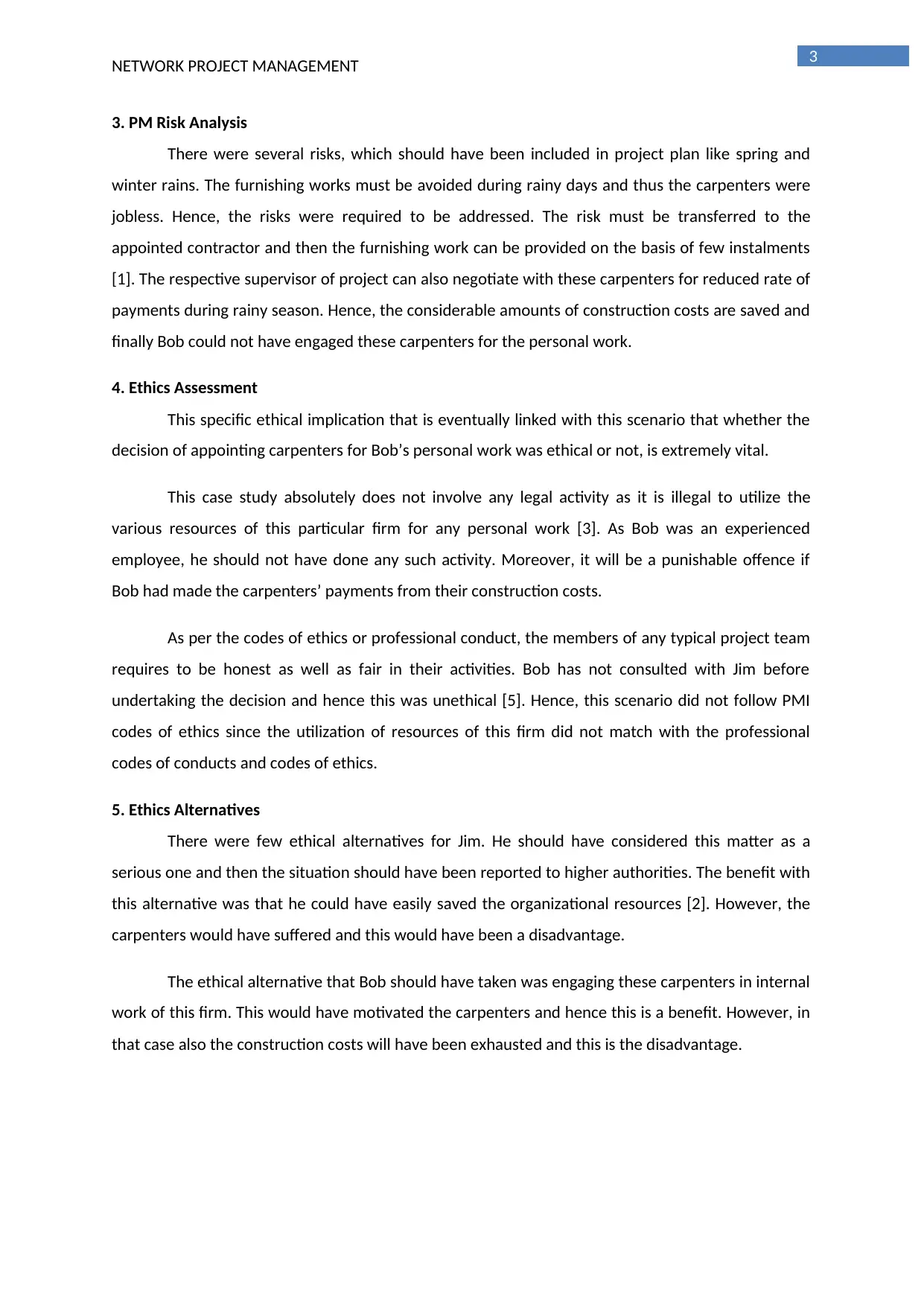
3
NETWORK PROJECT MANAGEMENT
3. PM Risk Analysis
There were several risks, which should have been included in project plan like spring and
winter rains. The furnishing works must be avoided during rainy days and thus the carpenters were
jobless. Hence, the risks were required to be addressed. The risk must be transferred to the
appointed contractor and then the furnishing work can be provided on the basis of few instalments
[1]. The respective supervisor of project can also negotiate with these carpenters for reduced rate of
payments during rainy season. Hence, the considerable amounts of construction costs are saved and
finally Bob could not have engaged these carpenters for the personal work.
4. Ethics Assessment
This specific ethical implication that is eventually linked with this scenario that whether the
decision of appointing carpenters for Bob’s personal work was ethical or not, is extremely vital.
This case study absolutely does not involve any legal activity as it is illegal to utilize the
various resources of this particular firm for any personal work [3]. As Bob was an experienced
employee, he should not have done any such activity. Moreover, it will be a punishable offence if
Bob had made the carpenters’ payments from their construction costs.
As per the codes of ethics or professional conduct, the members of any typical project team
requires to be honest as well as fair in their activities. Bob has not consulted with Jim before
undertaking the decision and hence this was unethical [5]. Hence, this scenario did not follow PMI
codes of ethics since the utilization of resources of this firm did not match with the professional
codes of conducts and codes of ethics.
5. Ethics Alternatives
There were few ethical alternatives for Jim. He should have considered this matter as a
serious one and then the situation should have been reported to higher authorities. The benefit with
this alternative was that he could have easily saved the organizational resources [2]. However, the
carpenters would have suffered and this would have been a disadvantage.
The ethical alternative that Bob should have taken was engaging these carpenters in internal
work of this firm. This would have motivated the carpenters and hence this is a benefit. However, in
that case also the construction costs will have been exhausted and this is the disadvantage.
NETWORK PROJECT MANAGEMENT
3. PM Risk Analysis
There were several risks, which should have been included in project plan like spring and
winter rains. The furnishing works must be avoided during rainy days and thus the carpenters were
jobless. Hence, the risks were required to be addressed. The risk must be transferred to the
appointed contractor and then the furnishing work can be provided on the basis of few instalments
[1]. The respective supervisor of project can also negotiate with these carpenters for reduced rate of
payments during rainy season. Hence, the considerable amounts of construction costs are saved and
finally Bob could not have engaged these carpenters for the personal work.
4. Ethics Assessment
This specific ethical implication that is eventually linked with this scenario that whether the
decision of appointing carpenters for Bob’s personal work was ethical or not, is extremely vital.
This case study absolutely does not involve any legal activity as it is illegal to utilize the
various resources of this particular firm for any personal work [3]. As Bob was an experienced
employee, he should not have done any such activity. Moreover, it will be a punishable offence if
Bob had made the carpenters’ payments from their construction costs.
As per the codes of ethics or professional conduct, the members of any typical project team
requires to be honest as well as fair in their activities. Bob has not consulted with Jim before
undertaking the decision and hence this was unethical [5]. Hence, this scenario did not follow PMI
codes of ethics since the utilization of resources of this firm did not match with the professional
codes of conducts and codes of ethics.
5. Ethics Alternatives
There were few ethical alternatives for Jim. He should have considered this matter as a
serious one and then the situation should have been reported to higher authorities. The benefit with
this alternative was that he could have easily saved the organizational resources [2]. However, the
carpenters would have suffered and this would have been a disadvantage.
The ethical alternative that Bob should have taken was engaging these carpenters in internal
work of this firm. This would have motivated the carpenters and hence this is a benefit. However, in
that case also the construction costs will have been exhausted and this is the disadvantage.
Paraphrase This Document
Need a fresh take? Get an instant paraphrase of this document with our AI Paraphraser
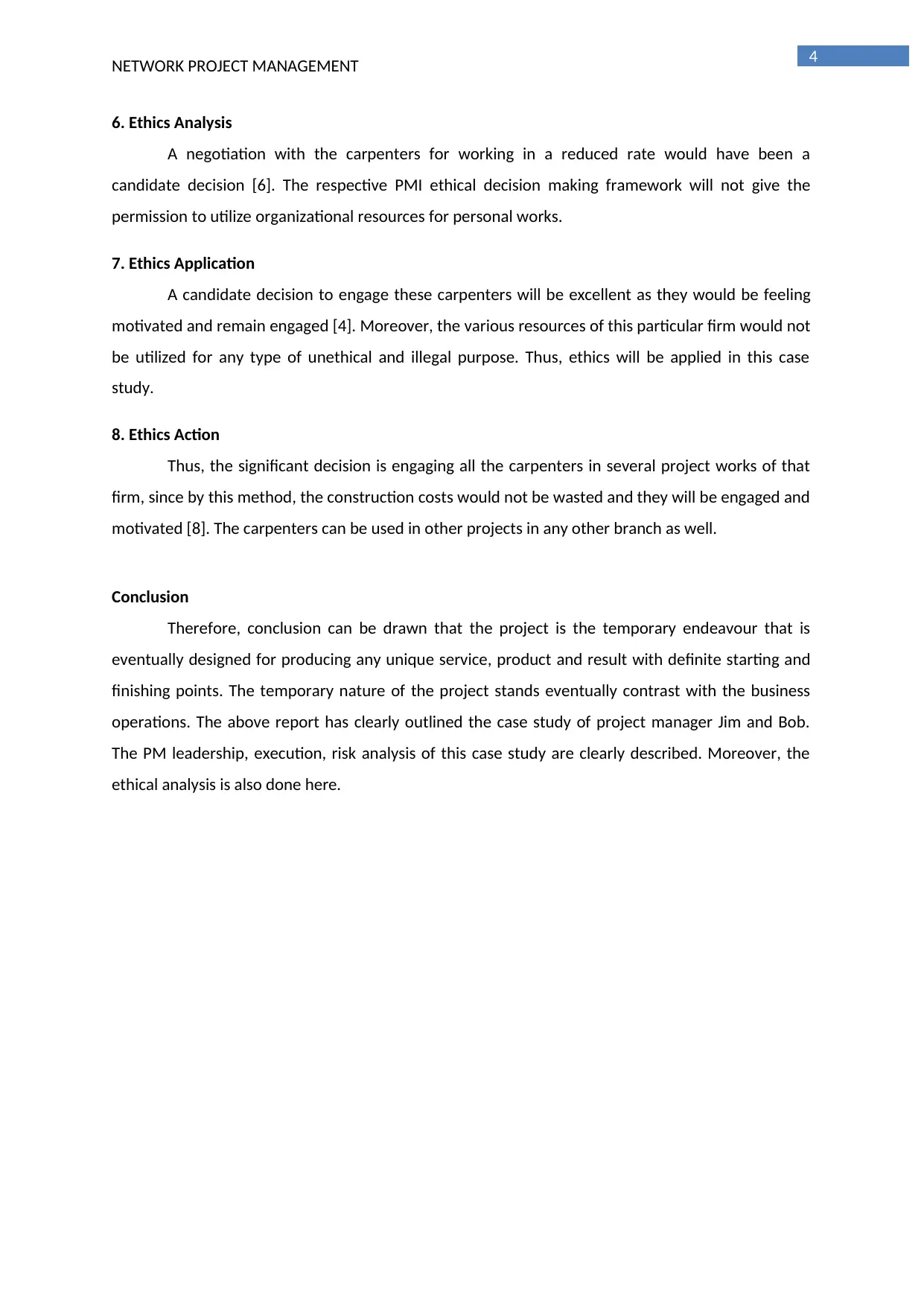
4
NETWORK PROJECT MANAGEMENT
6. Ethics Analysis
A negotiation with the carpenters for working in a reduced rate would have been a
candidate decision [6]. The respective PMI ethical decision making framework will not give the
permission to utilize organizational resources for personal works.
7. Ethics Application
A candidate decision to engage these carpenters will be excellent as they would be feeling
motivated and remain engaged [4]. Moreover, the various resources of this particular firm would not
be utilized for any type of unethical and illegal purpose. Thus, ethics will be applied in this case
study.
8. Ethics Action
Thus, the significant decision is engaging all the carpenters in several project works of that
firm, since by this method, the construction costs would not be wasted and they will be engaged and
motivated [8]. The carpenters can be used in other projects in any other branch as well.
Conclusion
Therefore, conclusion can be drawn that the project is the temporary endeavour that is
eventually designed for producing any unique service, product and result with definite starting and
finishing points. The temporary nature of the project stands eventually contrast with the business
operations. The above report has clearly outlined the case study of project manager Jim and Bob.
The PM leadership, execution, risk analysis of this case study are clearly described. Moreover, the
ethical analysis is also done here.
NETWORK PROJECT MANAGEMENT
6. Ethics Analysis
A negotiation with the carpenters for working in a reduced rate would have been a
candidate decision [6]. The respective PMI ethical decision making framework will not give the
permission to utilize organizational resources for personal works.
7. Ethics Application
A candidate decision to engage these carpenters will be excellent as they would be feeling
motivated and remain engaged [4]. Moreover, the various resources of this particular firm would not
be utilized for any type of unethical and illegal purpose. Thus, ethics will be applied in this case
study.
8. Ethics Action
Thus, the significant decision is engaging all the carpenters in several project works of that
firm, since by this method, the construction costs would not be wasted and they will be engaged and
motivated [8]. The carpenters can be used in other projects in any other branch as well.
Conclusion
Therefore, conclusion can be drawn that the project is the temporary endeavour that is
eventually designed for producing any unique service, product and result with definite starting and
finishing points. The temporary nature of the project stands eventually contrast with the business
operations. The above report has clearly outlined the case study of project manager Jim and Bob.
The PM leadership, execution, risk analysis of this case study are clearly described. Moreover, the
ethical analysis is also done here.
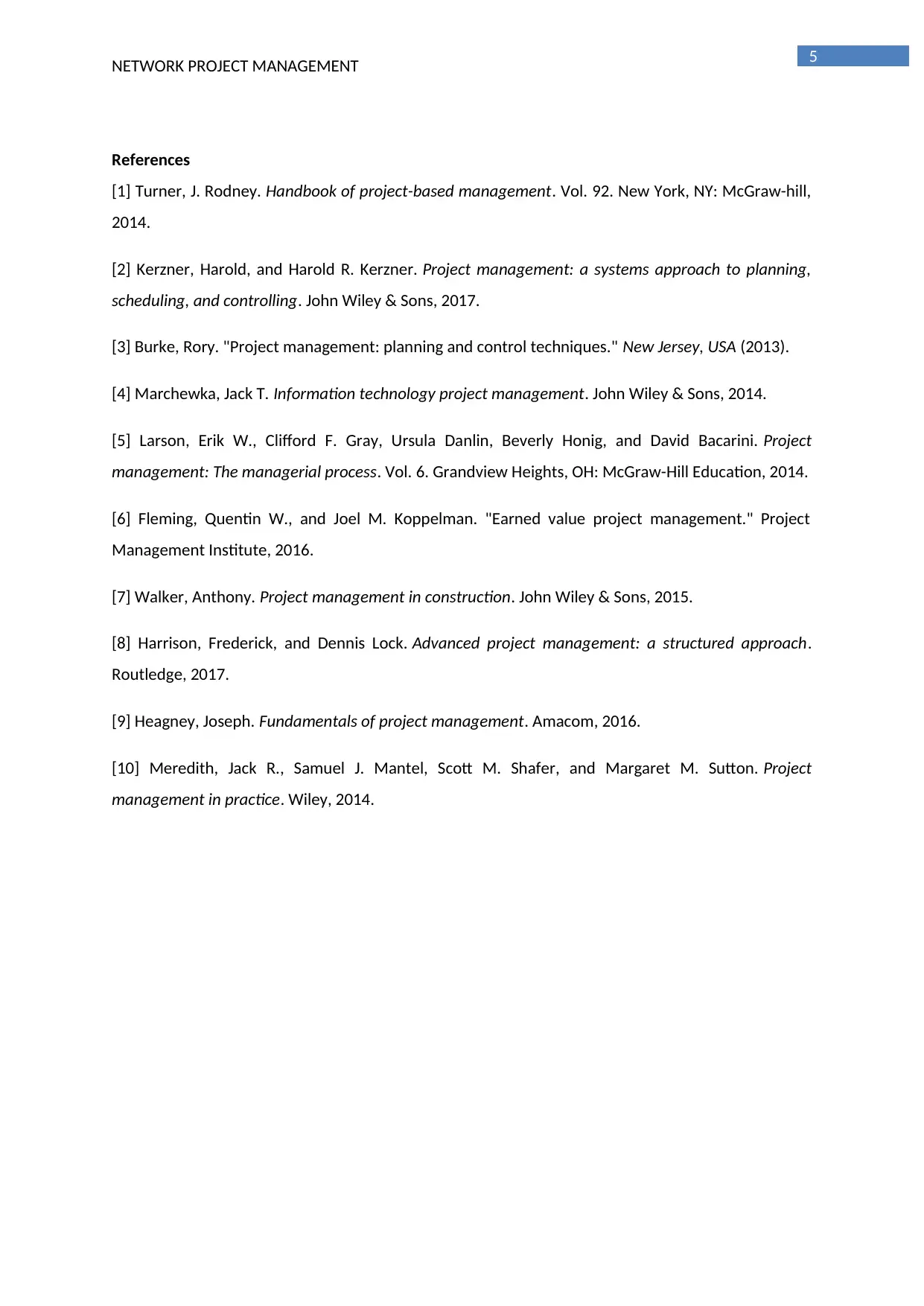
5
NETWORK PROJECT MANAGEMENT
References
[1] Turner, J. Rodney. Handbook of project-based management. Vol. 92. New York, NY: McGraw-hill,
2014.
[2] Kerzner, Harold, and Harold R. Kerzner. Project management: a systems approach to planning,
scheduling, and controlling. John Wiley & Sons, 2017.
[3] Burke, Rory. "Project management: planning and control techniques." New Jersey, USA (2013).
[4] Marchewka, Jack T. Information technology project management. John Wiley & Sons, 2014.
[5] Larson, Erik W., Clifford F. Gray, Ursula Danlin, Beverly Honig, and David Bacarini. Project
management: The managerial process. Vol. 6. Grandview Heights, OH: McGraw-Hill Education, 2014.
[6] Fleming, Quentin W., and Joel M. Koppelman. "Earned value project management." Project
Management Institute, 2016.
[7] Walker, Anthony. Project management in construction. John Wiley & Sons, 2015.
[8] Harrison, Frederick, and Dennis Lock. Advanced project management: a structured approach.
Routledge, 2017.
[9] Heagney, Joseph. Fundamentals of project management. Amacom, 2016.
[10] Meredith, Jack R., Samuel J. Mantel, Scott M. Shafer, and Margaret M. Sutton. Project
management in practice. Wiley, 2014.
NETWORK PROJECT MANAGEMENT
References
[1] Turner, J. Rodney. Handbook of project-based management. Vol. 92. New York, NY: McGraw-hill,
2014.
[2] Kerzner, Harold, and Harold R. Kerzner. Project management: a systems approach to planning,
scheduling, and controlling. John Wiley & Sons, 2017.
[3] Burke, Rory. "Project management: planning and control techniques." New Jersey, USA (2013).
[4] Marchewka, Jack T. Information technology project management. John Wiley & Sons, 2014.
[5] Larson, Erik W., Clifford F. Gray, Ursula Danlin, Beverly Honig, and David Bacarini. Project
management: The managerial process. Vol. 6. Grandview Heights, OH: McGraw-Hill Education, 2014.
[6] Fleming, Quentin W., and Joel M. Koppelman. "Earned value project management." Project
Management Institute, 2016.
[7] Walker, Anthony. Project management in construction. John Wiley & Sons, 2015.
[8] Harrison, Frederick, and Dennis Lock. Advanced project management: a structured approach.
Routledge, 2017.
[9] Heagney, Joseph. Fundamentals of project management. Amacom, 2016.
[10] Meredith, Jack R., Samuel J. Mantel, Scott M. Shafer, and Margaret M. Sutton. Project
management in practice. Wiley, 2014.
⊘ This is a preview!⊘
Do you want full access?
Subscribe today to unlock all pages.

Trusted by 1+ million students worldwide
1 out of 6
Related Documents
Your All-in-One AI-Powered Toolkit for Academic Success.
+13062052269
info@desklib.com
Available 24*7 on WhatsApp / Email
![[object Object]](/_next/static/media/star-bottom.7253800d.svg)
Unlock your academic potential
Copyright © 2020–2025 A2Z Services. All Rights Reserved. Developed and managed by ZUCOL.



